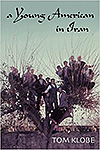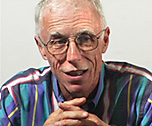Tom Klobe (Iran 1964–66) publishes A YOUNG AMERICAN IN IRAN
In November 1963, a bright Hawaiian morning is shattered by news of the assassination of the President. This marks the beginning of a journey to a remote Iranian village by a young American Peace Corps Volunteer who sets out with rebellious tenacity to do what is right, unaware of America’s loss of innocence — and his own.
From a youthful determination to perpetuate Kennedy’s legacy, to coping with the reality of America’s faults and ambitions, to grappling with unfamiliar customs and languages, to discovering the friendship and love of Iranians, Tom Klobe discovers that being “Tom of Iran” is as fulfilling as being “American Tom.”
 A Young American in Iran is a tribute to the people of the village of Alang and Iran — to their love and to their goodness. It strives to capture the essence of life in a specific village and Iran in the mid-1960s. It is also the story of an individual attempting to understand others and their culture, and of his attendant initial frustrations trying to fit in. Ultimately he realizes the depth of his love for the people and for a country in which he is always the outsider. It is an account of growing in a special kind of wisdom that cannot be learned within the context of formal education, of knowing you can be an idealist —always — but that you must have your feet firmly planted on the ground.
A Young American in Iran is a tribute to the people of the village of Alang and Iran — to their love and to their goodness. It strives to capture the essence of life in a specific village and Iran in the mid-1960s. It is also the story of an individual attempting to understand others and their culture, and of his attendant initial frustrations trying to fit in. Ultimately he realizes the depth of his love for the people and for a country in which he is always the outsider. It is an account of growing in a special kind of wisdom that cannot be learned within the context of formal education, of knowing you can be an idealist —always — but that you must have your feet firmly planted on the ground.
The idea of writing about the nearly two years the author lived in Alang in northern Iran as a Peace Corps Volunteer never occurred to him until 2011 when he attended an Iran Returned Peace Corps Volunteer reunion in Portland, Oregon. There, he realized his connection to the village and its people was profound and long-lasting. He finally understood the singular importance of his situation. Few other Volunteers who served in Iran had lived in a remote village and thus missed the opportunity to encounter isolation from American norms and experience cultural assimilation to the degree he had. He left the reunion still not aware of the need to document what happened in those years and how it influenced his life. However, before he reached home, his determination to record the story was set.
The author grew up on a small farm in an all-white community near Young America, Minnesota. So, in a way, he was a Young American through and through. His parents taught his brother and him to believe in the American ideals of freedom and democracy, in the rights and privileges of being an individual, and, most importantly, that “all men are created equal.”
Life was an endless whirlwind of dizzying dichotomies. They were quiet liberals in a conservative community, staunch Catholics, but from early on Klobe was apprehensive of the clergy. He and his brother respected their parents because they deserved their adulation, but they taught their sons to question authority. They were fiercely independent and proud of it, even if it hurt. “Always do the right thing, no matter how difficult it is,æ his parents would tell them.
When the family moved to Hawaii in 1959, a year after the author finished high school, he could freely live the American ideals his parents had instilled. Freed from the American norm, and realizing that democracy thrives on pluralism and diversity, he could now truly be an individual. Foremost, he saw and understood the necessity of equality for all people, and knew he had to work to ensure that all would have the same opportunities. Yet his aptitudes and interests were in art, and he would strive to find ways to mesh his chosen career with his philosophical thought. Iran and the Peace Corps were a diversion, a solidifying element that provided his life with professional, intellectual, emotional, and spiritual depth. To say his adopted country of Iran and the Peace Corps were life-changing cannot adequately describe the significance of both.
 As a Peace Corps Volunteer in Iran, Tom Klobe learned the persuasive qualities of quiet leadership that enlightened his 29-year career as Director of the University of Hawaii Art Gallery. He organized and designed over 200 exhibitions, five of which received the prestigious Print Casebooks: Best in Exhibition Design award. His book Exhibitions: Concept, Planning and Design was published by the American Association of Museums Press in 2012. He has authored or edited over 35 publications.
As a Peace Corps Volunteer in Iran, Tom Klobe learned the persuasive qualities of quiet leadership that enlightened his 29-year career as Director of the University of Hawaii Art Gallery. He organized and designed over 200 exhibitions, five of which received the prestigious Print Casebooks: Best in Exhibition Design award. His book Exhibitions: Concept, Planning and Design was published by the American Association of Museums Press in 2012. He has authored or edited over 35 publications.
Klobe was named a Living Treasure of Hawaii in 2005 and was the recipient of the University of Hawaii Robert W. Clopton Award for Distinguished Community Service in 2003. In 1999 he was honored by the Republic of France as a Chevalier de l’Ordre des Arts et des Lettres for his contributions to the arts in France and Hawaii.
•
A Young American in Iran
by Tom Klobe (Iran 1964–66)
A Peace Corps Writers Book
December 2014
530 pages
$19.95 (paperback)
.
To purchase the books mentioned here, click on the book cover, the bold book title or the publishing format you would like — and Peace Corps Worldwide, an Amazon Associate, will receive a small remittance that will help support its annual writers awards.
No comments yet.
Add your comment